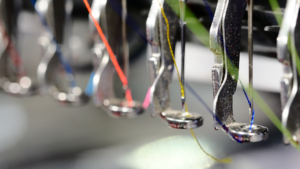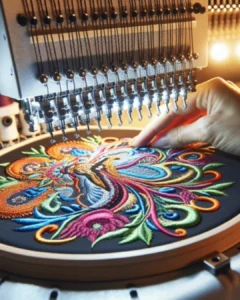The Role Of Embroidery Placement For Maximum Brand Exposure
Have you ever wondered why some brands seem to be everywhere? Or why certain logos stick in your mind more than others? It’s not just the design of the logo that matters – where that logo appears plays a huge role too. Embroidery placement can either make or break the visibility of your brand. So, let’s talk about the art and science behind this, and how you can use embroidery placement to ensure maximum brand exposure.

This image is property of images.unsplash.com.
Why Placement Matters
When it comes to branding, visibility is key. But visibility isn’t just about slapping your logo on as many surfaces as possible. The placement of your embroidery can determine how often people notice and remember your brand. This is crucial in a world where countless brands are vying for attention.
Creating First Impressions
First impressions count. The location of your embroidered logo can make your brand look professional or amateurish. For instance, a well-placed logo on a well-designed uniform can make employees appear more trustworthy and competent.
Capturing Eyeballs
Certain placements are more likely to be noticed by people. A logo on a cap, for example, is often at eye level, making it hard to miss. Meanwhile, a logo on the back of a jacket might be overlooked completely unless someone is directly behind you.
Reinforcing Brand Memory
The more often a viewer sees your logo, the more likely they are to remember it. Strategic placement can increase how frequently your logo is seen, thus reinforcing brand memory.
Optimal Placement on Garments
Different garments offer different opportunities for brand exposure. Understanding where to place embroidery on each type of clothing can make all the difference.
T-Shirts and Polos
For t-shirts and polos, embroidery on the left chest area is a classic choice. This area is immediately noticeable and doesn’t obstruct the natural flow of the garment. Some brands also use the right chest or even center chest areas for a bolder statement.
Jackets and Outerwear
Jackets offer larger real estate and more creative freedom. The upper back, sleeve, and chest areas are all good options. Each placement has its own advantages. For instance, placing a logo on the sleeve is subtle but can be very effective when the wearer gestures.
Caps and Hats
Caps and hats bring your logo to eye level. The most common placement is on the front panel of the cap, which offers high visibility. Some brands also opt for the side or back to create a more unique look.
Bags and Accessories
Bags and accessories are often used daily, offering constant brand exposure. The front pocket area of a backpack or the side of a tote bag are prime real estate. These areas are frequently visible and can effectively advertise your brand.
| Garment Type | Optimal Placement Areas |
|---|---|
| T-Shirts and Polos | Left Chest, Right Chest, Center Chest |
| Jackets | Upper Back, Sleeve, Chest |
| Caps | Front Panel, Side Panel, Back Panel |
| Bags | Front Pocket, Side Panel |

This image is property of images.unsplash.com.
Industry-Specific Considerations
Different industries have different norms and expectations when it comes to uniform and branding. Let’s break down how embroidery placement varies across some key sectors.
Corporate and Office Environments
In corporate settings, less is often more. Subtle and sophisticated placements are preferred. The left chest area of shirts and blazers is a popular choice, keeping the branding professional and understated.
Sports and Fitness
Sportswear is all about bold, eye-catching designs. Large logo placements on the chest, back, and sleeves are common. This not only ensures visibility but also creates a dynamic and energetic look.
Retail and Hospitality
In the retail and hospitality sectors, employee uniforms need to be both functional and stylish. Logos on aprons, hats, and front pocket areas work well. These spots offer visibility without compromising the practicality of the uniform.
Healthcare
In healthcare, practicality is paramount. Logos are often placed on the chest area of scrubs or lab coats. This ensures that the branding is visible without interfering with the function of the garment.
The Fine Line Between Visibility and Overkill
One crucial aspect of embroidery placement is maintaining a balance between visibility and subtlety. Too much branding can appear aggressive, while too little can go unnoticed.
Less is More
Subtle branding can often be more effective than overwhelming a garment with logos. A single, well-placed logo can create a more sophisticated and memorable impression than multiple scattered logos.
Quality Over Quantity
Focusing on the quality of the embroidery and its placement is more important than the quantity. High-quality, well-placed embroidery tells the viewer that your brand values quality and attention to detail.

This image is property of images.unsplash.com.
Technical Aspects of Embroidery Placement
Understanding the technical constraints and possibilities of embroidery can help you make more informed decisions. Different fabrics and garment types may affect your placement choices.
Fabric Considerations
Certain fabrics are more suited to embroidery than others. For instance, thick fabrics like denim and canvas can handle larger, more complex designs. In contrast, thinner fabrics like silk or polyester may require simpler, smaller logos.
Embroidery Techniques
Different embroidery techniques can affect your placement options. Techniques such as 3D puff embroidery or applique can add dimension and interest to your logo, but they also require specific placement to be effective.
Sizing and Scaling
The size and scale of your logo are also crucial. A logo that’s too small might be overlooked, while one that’s too large can appear gaudy. Test different sizes on different garments to find the optimal balance.
Case Studies
Successful Embroidery Placement
Nike
Nike has mastered the art of embroidery placement. Their iconic swoosh logo is strategically placed on their apparel to ensure maximum brand exposure while maintaining a clean and modern look. For example, on their athletic wear, the swoosh often appears on the upper chest or sleeve, locations that draw the eye during physical activity.
| Item | Placement |
|---|---|
| Athletic Shirt | Upper Chest, Sleeve |
| Cap | Front Panel |
| Jacket | Chest, Upper Back |
Starbucks
Starbucks has also done an excellent job with their embroidery placement in their staff uniforms. The logo is usually found on the aprons and chest area of t-shirts, ensuring that it is visible to customers at all times.
| Item | Placement |
|---|---|
| Apron | Front Center |
| T-shirt | Left Chest |
| Cap | Front Panel |
Common Pitfalls and How to Avoid Them
Overbranding
One common mistake is overbranding, where multiple logos appear on different areas of the same garment. This can look cluttered and unprofessional. Stick to one or two key areas to maintain a clean and effective design.
Poor Quality Embroidery
Another pitfall is poor-quality embroidery. Even the best placement won’t help if the embroidery is subpar. Invest in high-quality materials and skilled craftsmanship to ensure your logos look their best.

DIY or Professional Help?
Should you handle embroidery placement yourself or hire a professional? Both approaches have their advantages and disadvantages.
DIY: Pros and Cons
Doing it yourself can save money, and you have complete control over the process. However, it also requires a significant investment of time and effort to get right. Mistakes can be costly and time-consuming to fix.
Hiring a Professional
Hiring a professional ensures that you get high-quality results and expert advice on placement. Professionals have the experience and tools needed to execute your vision perfectly. The downside is the higher cost.
How to Test Your Placement
Before committing to a large order, it’s essential to test your embroidery placement.
Mock-Ups
Create mock-ups of your designs on different garments. This can give you a better idea of how your placement will look in real life.
Wear Tests
Have employees or volunteers wear the test garments in real situations. This can provide valuable feedback on visibility and practicality.
Customer Feedback
If you’ve already launched some products, pay attention to customer feedback. Are they commenting on the logo placement, either positively or negatively? Use this feedback to inform future decisions.

Future Trends in Embroidery Placement
Sustainable Choices
As brands become more environmentally conscious, sustainable fabrics and eco-friendly embroidery threads are gaining popularity. This trend extends to placement strategies, with companies opting for smaller, more subtle logos to reduce material use.
Technological Advancements
Advances in technology are also influencing embroidery placement. For example, smart fabrics with integrated sensors might dictate new and innovative placement to work with the technology embedded in the garments.
Personalized Branding
Personalization is another growing trend. Instead of one-size-fits-all placements, companies are offering customers the option to choose where they want the embroidery on their custom items.
Embroidery Placement Best Practices
To wrap things up, let’s summarize the best practices for embroidery placement to ensure your brand gets the exposure it deserves.
| Best Practice | Description |
|---|---|
| Understand Your Audience | Know who will be wearing the items and what they prefer. |
| Test Multiple Placements | Create mock-ups and conduct wear tests before finalizing. |
| Focus on High-Visibility Areas | Prioritize placement areas that receive the most attention. |
| Balance Visibility and Subtlety | Avoid overbranding; keep it simple and effective. |
| Invest in Quality | Use high-quality materials and craftsmanship for the best results. |
| Tailor to Industry Needs | Customize your placement strategy based on your industry’s norms. |
| Leverage Professional Advice | Don’t hesitate to consult experts for optimal results. |
Conclusion
Embroidery placement is more than just an afterthought; it’s a strategic decision that can significantly impact your brand’s visibility and perception. By understanding your audience, testing placements, and investing in quality, you can ensure your embroidered logos do their job effectively. Follow these best practices, and watch your brand stand out in a crowded marketplace.



